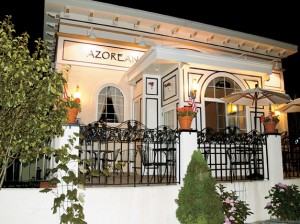Charlene Peters went to San Miguel to find family. While there she fell in love with the food and viniculture. Returning home, she finds ways to repeat the pleasure.
The winds blow from the westin the countryside of San Miguel, the largest of nine islands in the Azores, a thousand miles west of Portugal, of which they are a part. San Miguel is where the beauty of Switzerland, New Zealand, and Hawaii converge into what King Charles of Portugal, in 1901, called “the most beautiful landscape in the world.”
With a maritime climate where the temperature never falls below 50 degrees Fahrenheit and seven wondrous crater lakes and the Furnas hot springs, San Miguel offers an island of majestic proportion and culinary delights that beckon visitors to explore and emigrants to come home to.
Driven out by the poor economy, many Micaelense left more than 50 years ago; some headed to Canada, while others moved to the United States. Many settled in Peabody and Gloucester. Today San Miguel has a population of 110,000, and many residents travel back and forth to Massachusetts to visit relatives. Luis Nunes, one of my tour guides, visits his relatives on occasion in New Bedford, where many have the surname Medeiros (pronounced “Madayroshe” in San Miguel) – my maiden name.
I traveled to San Miguel to explore my family roots, and made connections at every turn. At the Ponta Delgada airport Maria Medeiros helped my travel companion with her lost luggage. Two days later, my tour guide, Ana Silva, told me her mother’s maiden name is Medeiros. To put this in better perspective: the phonebook at my hotel had two-and-a-half pages of listings for Medeiros – and not a single Smith.
I have discovered the land of my people, and enjoy connecting with the land where my grandfather was born, in the tiny village of Arrifes. After my return to the US, a chance encounter with Ana Patuleia Ortins, a Portuguese cookbook author who lives in Peabody, revived memories of my trip. She has just returned from a visit to Portugal and her cookbook, “Portuguese Homestyle Cooking,” is scheduled for its third printing in August.
Between the many North Shore Micaelense and Portuguese connections we discuss, all I really want to talk about is how to fulfill my quest to savor more of the pureed vegetable soups I enjoyed in San Miguel. “The soups originated from the mainland,” says Ana, who then reads off a list of specialty ingredients from her recipes – chourico and linguica (Portuguese smoked sausages) that can be found on the North Shore, in Peabody at Tremont Market and at New England Meat Market.
Sausages are not my favorite food, but I like to explore all options. In the eastern area of San Miguel, Furnas is one of the last places the Micaelanse settled, as they believed the many active hot springs represented hell on earth. Ironically, it is now the most beautiful and popular area for tourism, and there has been little activity since the last eruption in 1613. It is here that I experienced my first taste of a blood sausage.
The “underground stew” at Terra Nostra, a restaurant in Furnas surrounded by active hot springs, was an experience to remember. Cooked for six hours in a pot under a steamy ground of high temperature soil, lunch was an assortment of beef, chicken, pork, white and sweet potatoes, carrots, cabbage, kale, red sausage, and black (blood) sausage, the latter a local favorite of coagulated animal blood mixed with pork fat. I could have lived a full life without ever having tried this sausage. The soup, or sopa, is what I want more of on the North Shore.
On Ana’s recommendation, I visit the Azorean Restaurant in Gloucester, where I am catapulted back to San Miguel through the Azores-inflected staff, food, wine and decor offered. When I make dinner reservations and speak with the manager, Jesse Correia, he tells me,”When you walk in here, you don’t see Gloucester anymore.” When I arrive, I know he was right. Hand-painted murals on the walls lead me back to San Miguel, hiking along the iron-rich soil that marks the curving trails lined with Japanese cedars and fragrant African lilies, hydrangeas, and azaleas in bloom. Aside from the Azorean decor, the restaurant offers authentic Micaelense cuisine mixed with American favorites, such as stuffed haddock, always a great choice. When he opened the restaurant almost two years ago, owner Cliff Braga wanted to offer patrons a chance to visit San Miguel and experience the Portuguese way of life. Even the menu covers are made of cork, as a reminder that Portugal is the largest producer of these harvested oak trees.
Viniculture is a large part of Portugal’s economy, and at the Azorean Restaurant, a wine cellar is stocked with Portugal’s many wine offerings, made in the tradition of foot-stomped grapes. San Miguel has but a few vineyards, but offers many wines of Portugal. My memories float back to the black, fine sand beach at São Roque and the orchestra of nearby birds and crashing waves. The beachside Pó Pu Lo Cafe was where I first sipped on a 2005 Castello D’Alba, from the Douro region of Portugal. This ruby red wine offers a sweet velvet texture with oak undertones and plum overtones in a robust finish. The wine list at Azorean offers a 2003 Castello D’Alba Reserve, and it is splendid.
A mystical land where its inhabitants once struggled to survive, today, San Miguel is the perfect vacation spot. I never did make specific connections with my own extended family during my stay on San Miguel island, but as a whole, the island and its people offered me a connection to my roots – with the bonus of experiencing heaven on earth.

